St Andrew's Anglican Church
cnr New & Church Streets, Brighton
First organ, B. c.1842 Peter Hurlstone
Second organ, B c.1857 Jesse Biggs, later at Wesley Church, Ballarat,
Methodist Church, Pleasant Street, Ballarat,
St Mark's Anglican Church, Camberwell and
St Paul's Anglican Church, Fairfield, broken up.c.1968
Third organ, B. 1858 Hill & Son, installed 1860,
see: St Peter's Lutheran Church, Stawell
Fourth organ, B 1923 Roberts Ltd;
elec 1930, 1941 W.L. Roberts; destroyed by fire 1961.
3 manuals, 32 speaking stops.
Present organ, B 1962-64 Davis & Laurie;
addtns 1973 Laurie Pipe Organs (great reeds, pedal 32 flue and upperwork);
res & revoiced 1988-89 with addtn (32 reed) S.J. Laurie.
4m, 64spst, 12c, elpn, 2 consoles.

Historical and Technical Documentation by John Maidment
© OHTA 2008 (last updated October 2020)

ST ANDREW’S ANGLICAN CHURCH, BRIGHTON
The history of the Anglican church on this site dates back more than 160 years. The first two buildings, from the 1840s and 1850s, have been demolished.
The third church was begun in 1855 and completed in 1857 to the design of Webb & Taylor. Part of the original nave survives as the pioneer chapel of the present church. It is constructed of bluestone with a prominent bellcote surmounting the gable. It has been designed in a simplified gothic style without elaboration.
In August 1886, new Oamaru stone transepts, chancel, apse and the first section of a new nave in elaborate decorated gothic style were opened, this costing £7,000. The architect was Lloyd Tayler. His grand design remained incomplete until the church was largely destroyed by fire on 19 February 1961.
The present building was designed by Louis R. Williams and was opened on 15 December 1962. The total cost was £185,000. The building has a steel frame with brown brick used for the exterior and cream brick for the interior which has a ceiling of anodised aluminium tiles. It is of cruciform shape with shallow transepts. The dimensions are most spacious: the building is almost 200 ft long; the copper flèche over the crossing is 115ft high and the height of the nave is 47ft. This is the largest post-war church in the Anglican Diocese of Melbourne and Williams's last major work. It is comparable stylistically with his slightly earlier St John's, Camberwell.
The interior of St Andrew's focuses on the large wooden high altar 13ft wide upon which is often placed a silver altar cross (137 cm - 4ft 6in high) and candlesticks, made by J.W. Steeth & Son, Melbourne to the design of Louis Williams. The sanctuary floor is of parquetry (Johnson River hardwood from Queensland) while the large bronze sculpture at the base of the rear wall is by Guy Boyd (1987) and depicts The Return of the Prodigal Son.
The metal work (pulpit, lectern and font cover) is by Reine Slagmolen. The pews and fittings are of mountain ash and were all designed by Williams.
The Pioneer Memorial chapel comprises a section of the 1850s nave. The large mural is by Napier Waller and depicts the pioneers of Brighton landing from Port Phillip Bay and setting about the task of building a new church. Many of the windows here have been filled with memorial stained glass from 1984 onwards.
The separate Lady Chapel to the left of the chancel is known as the Chapel of the Incarnation and incorporates stained glass by D. Taylor Kellock, a Scottish-trained local maker favoured by the architect.
The first organ in St Andrew's Church was built by Peter Hurlstone, who was born in 1802 and arrived in Australia in 1838. He was trained as a millwright but clearly had mechanical skills. He also installed the Richard Nicholson organ at Wesley Church in Collins Street, Melbourne, in 1842. Little is known about the first Brighton organ.
The church's second organ by was built c.1857 by Jesse Biggs, who had arrived in Melbourne in 1856 and had been trained with Gray & Davison, London. This was a large single manual organ of nine speaking stops, up to a Mixture and had a Gothic-style case. This organ was moved in 1860 to the Wesleyan Church, Lydiard Street, Ballarat, and was later placed in the Methodist Church, Pleasant Street, Ballarat, St Mark's Anglican Church, Camberwell and finally in St Paul's Anglican Church, Fairfield in the late 1920s; it was broken up c.1968. The specification was noted at this time by John Maidment.
| MANUAL Open Diapason Bass Open Diapason Stopped Diapason Bass Stopped Diapason Treble Dulciana Principal Flute Twelfth Fifteenth Mixture Manual to Pedal PEDAL Bourdon |
8 8 8 8 4 4 2-2/3 2 II-III 16 |
(enclosed) CC-BB unenclosed wood TC CC-BB TC TC metal Chimney Flute with sealed tops and ear-tuned |
Compass: 54/30
Mechanical action
Trigger swell lever
This instrument was replaced in 1860 by an organ of outstanding tonal and visual quality built in 1858 by the leading London organbuilding firm of Hill & Son for the residence of Peter Davis, Great Dandenong Road, Prahran, which had two manuals and 12 speaking stops. It was probably placed initially in a rear gallery of the bluestone nave but later moved to the new chancel. The instrument was moved in 1923 to Holy Trinity Anglican Church, Stratford, in Gippsland, and then in 1969 to St Peter's Lutheran Church, Stawell where it still survives, with little alteration from the original.

The Hill & Son organ in St Peter's Lutheran Church, Stawell (JRM April 2009)
GREAT |
8 8 8 4 4 2-2/3 2 8 8 4 8 16 |
CC-FF# open wood inside organ wood, pierced stoppers in treble TC TC open wood (from TC, CC-BB from Great Stopped Diapason) wood |
compass: 54/30
3 composition pedals
Lever swell pedal
The fourth organ was built in 1923 by Roberts Ltd of Melbourne and Adelaide and was a substantial three manual instrument of 32 speaking stops with a case designed by Louis Williams. This was one of its builder's major works but slightly smaller than the almost contemporary organ at All Saints' Anglican Church, East St Kilda. It was placed on either side of the south transept and was totally destroyed in the 1961 fire. Two recordings of the organ have come to light. The organist is unknown but was possibly a student at Brighton Grammar.
Please click on links below to download:
Mendelssohn - Fugue in G Op 37/2
Boëllmann - Toccata from Suite Gothique
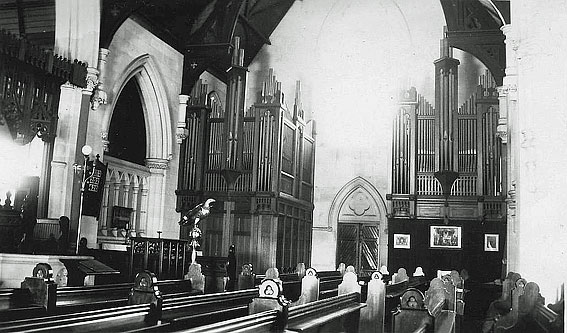
c. 1960


3 photos above: JRM
| GREAT Bourdon Open Diapason (large) Open Diapason (medium) Hohl Flute Octave Harmonic Flute Super Octave Mixture Tromba SWELL Bourdon Open Diapason Rohr Flöte Viole d’Gamba Viole Célestes Gemshorn Lieblich Flute Mixture Contra Fagotto Cornopean Oboe CHOIR (enclosed) Claribel Viole d’Orchestre Dulciana Flauto Traverso Clarinet Orchestral Oboe Tromba PEDAL Open Diapason Sub Bass Bourdon Bass Flute Trombone |
16 8 8 8 4 4 2 III 8 16 8 8 8 8 4 4 III 16 8 8 8 8 8 4 8 8 8 16 16 16 8 16 |
A * * B * GG * * * * * B wood C A C B * |
* prepared for
The present organ, a war memorial, was built in 1962-1964 by Davis & Laurie Pty Ltd, of Moorabbin. It has four manuals, 64 speaking stops and twin consoles. The majority of the instrument is placed in the rear gallery but an ancillary division (the first section of the instrument to be completed – this was initially placed in the rear gallery) is placed high up in the south transept.
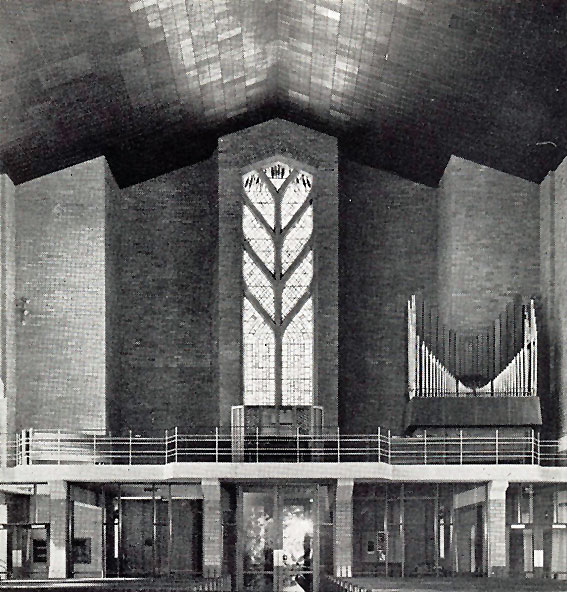
Transept organ initially placed in the rear gallery 1962 - early 1964
(St Andrew's Church Guidebook 1963)
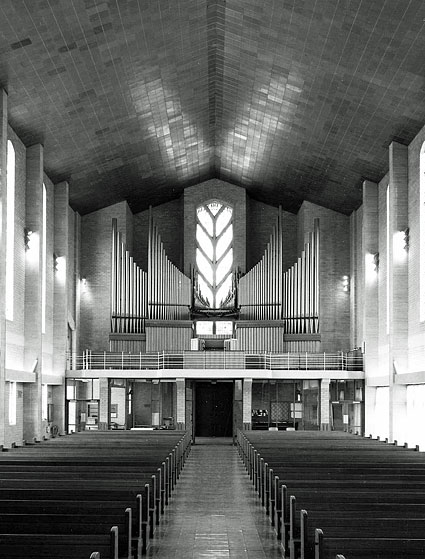

2 photos above commissioned by Steve Laurie
These two recordings were made by Ian Thomas during the 1960s when the church & organ were both new. Ian Thomas held the position of Organist & Choirmaster from February 1961 (the week of the fire) & 1974.
Please click on links below to download
Grieg - The Last Spring 7MB
Stanley - Trumpet Voluntary 5MB
Additions and alterations were made by S.J. Laurie Pty Ltd in 1973 and 1988-1989, when a full-length 32ft wooden reed stop was added. At the latter time, major revoicing of the organ took place in association with the organist of St Andrew’s, Lindsay O’Neill, to ‘Frenchify’ the sound and to offer improved tonal projection: the originally resonant acoustic had been considerably dampened down in 1974 through the insertion of baffles in the ceiling. The acoustic dampening has now been removed and the original resonance largely recreated.
The provision of twin four-manual consoles and the horizontal Festal Trumpet stop are distinctive features, the latter the first such stop in Australia.
The organ is heritage listed by the National Trust of Australia (Victoria) and is of considerable significance as the largest example of a totally new pipe organ built in Victoria at the time as well as remaining substantially intact.
| GREAT Contra Salicional Open Diapason I Open Diapason II Stopt Diapason Principal Harmonic Flute Fifteenth Quartane 12.15 Tierce Mixture 19.22.26.29 Trumpet Clarion Swell to Great Choir to Great Transept to Great SWELL Bourdon Open Diapason Gedeckt Salicional Vox Angelica Principal Chimney Flute Fifteenth Mixture 22.26.29 Hautboy Tremulant Double Trumpet Trumpet Octave Trumpet Super Octave CHOIR (a) enclosed Wald Flute Viola da Gamba Dulciana Salicet Larigot Flute Stopt Twelfth Piccolo Flute Tierce Flageolet Clarinet Tremulant (b) unenclosed Festal Trumpet Trumpet Clarion Swell to Choir Transept to Choir TRANSEPT (manual IV) Open Diapason Stopt Flute Gemshorn Octave Stopt Flute Gemshorn Super Octave Mixture 29.33.36 Sharp Mixture 19.22 PEDAL Sub Bourdon Open Wood Open Metal Contra Salicional Bourdon Principal Flute Fifteenth Quartane 12.15 Contra Bombarde Bombarde Double Trumpet Festal Trumpet Clarion Great to Pedal Swell to Pedal Choir to Pedal Transept to Pedal TRANSEPT PEDAL Bourdon Flute Flute Great & Pedal Pistons Coupled Transept to Great Pistons |
16 8 8 8 4 4 2 II 1-3/5 IV 8 4 16 8 8 8 8 4 4 2 III 8 16 8 4 8 8 8 4 4 2-2/3 2 1-3/5 1 8 8 8 4 8 8 8 4 4 4 2 III II 32 16 16 16 16 8 8 4 II 32 16 16 8 4 16 8 4 |
A bass in façade B C 1973 C 1973 originally Hohl Flute TC D D originally Cornopean D E horizontal from CC C E F G H F G H F H I bottom octave polyphonic B A I J 1973 I J J C 1-12 wood 1989 C D C C G G G |


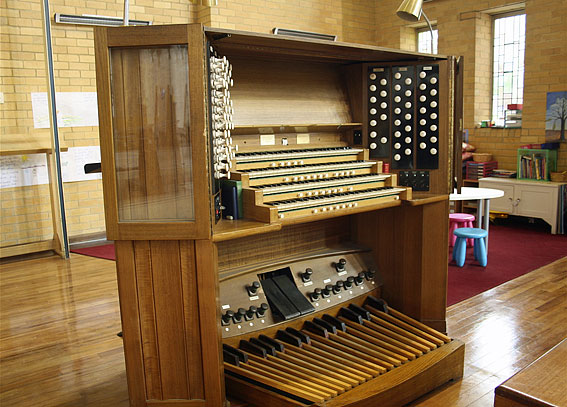




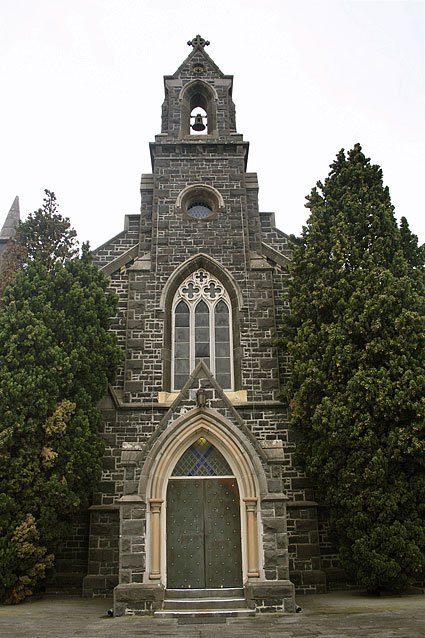

Photos: Trevor Bunning (April 2009)